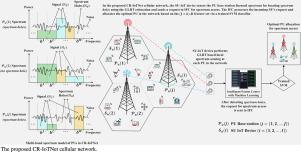Ad Hoc Networks ( IF 4.8 ) Pub Date : 2020-12-07 , DOI: 10.1016/j.adhoc.2020.102390 Ramsha Ahmed , Yueyun Chen , Bilal Hassan , Liping Du

|
In recent years, the Internet of Things (IoT) paradigm has gained much popularity due to its potential ability to integrate the physical world with the digital world. However, this digital revolution is driving an insatiable demand for wireless spectrum, leading the upcoming novel personal, social and industrial IoT applications competing for limited spectrum resources. One of the main challenges that may hinder the vision of IoT is the scarcity of radio spectrum. Therefore, in order to cope with the challenge of spectrum scarcity brought about by the unprecedented number of IoT devices, this paper proposes to integrate cognitive radio (CR) technology with the IoT paradigm (CR-IoTNet). The CR is realized as a promising solution to improve the spectrum utilization and alleviate the spectrum scarcity in wireless networks. In CR, spectrum sensing is widely recognized as a key technology that enables secondary users (SUs) to detect spectrum holes and have the opportunity to access unoccupied spectrum. The CR-IoTNet, which is composed of multiple primary user (PU) base-stations and SU devices as IoT smart objects, performs the joint spectrum sensing and optimal allocation of spectrum to the requesting SU-IoT devices in the network through an intelligent fusion center (IFC). Furthermore, we employ support vector machines (SVM) in CR-IoTNet, enabling it to learn and adapt to the changing network dynamics, and identify the PU spectrum usage based on the established multi-class -D feature set. The performance of CR-IoTNet is evaluated across several key factors, where simulation results validate the efficacy of the proposed framework in achieving high reliable identification, classification and allocation of unoccupied frequency bands in PU spectrum, especially in key areas of low signal-to-noise ratio (SNR). In addition, the trained SVM classifier obtained 95.11% accuracy, with 92.67% true positive rate and 96.34% true negative rate in CR-IoTNet, reflecting the optimal allocation of PU nodes for spectrum access.
中文翻译:

CR-IoTNet:基于机器学习的联合频谱感知和认知无线电物联网蜂窝网络的分配
近年来,物联网(IoT)范式因其具有将物理世界与数字世界整合的潜在能力而广受欢迎。但是,这场数字革命正在推动对无线频谱的无限需求,从而导致即将到来的新型个人,社交和工业物联网应用争夺有限的频谱资源。可能阻碍物联网愿景的主要挑战之一是无线电频谱的匮乏。因此,为了应对物联网设备数量空前带来的频谱稀缺的挑战,本文提出将认知无线电(CR)技术与物联网范式(CR-IoTNet)集成在一起。CR被认为是一种有前途的解决方案,可以提高频谱利用率并减轻无线网络中的频谱稀缺性。在CR中 频谱感测被公认为是一项关键技术,可使次要用户(SU)能够检测频谱空洞并有机会访问未占用的频谱。由多个主要用户(PU)基站和SU设备作为IoT智能对象组成的CR-IoTNet通过智能融合执行联合频谱感知和频谱优化分配给网络中请求的SU-IoT设备中心(IFC)。此外,我们在CR-IoTNet中采用了支持向量机(SVM),使其能够学习和适应不断变化的网络动态,并根据已建立的多类别识别PU频谱使用情况 它由多个主要用户(PU)基站和SU设备作为IoT智能对象组成,它通过智能融合中心(IFC)进行联合频谱感知和频谱优化分配给网络中请求的SU-IoT设备。此外,我们在CR-IoTNet中采用了支持向量机(SVM),使其能够学习和适应不断变化的网络动态,并根据已建立的多类别识别PU频谱使用情况 它由多个主要用户(PU)基站和SU设备作为IoT智能对象组成,它通过智能融合中心(IFC)进行联合频谱感知和频谱优化分配给网络中请求的SU-IoT设备。此外,我们在CR-IoTNet中采用了支持向量机(SVM),使其能够学习和适应不断变化的网络动态,并根据已建立的多类别识别PU频谱使用情况-D功能集。CR-IoTNet的性能在多个关键因素上进行了评估,其中仿真结果验证了所提出框架在实现PU频谱中未占用频段的高可靠识别,分类和分配方面的有效性,尤其是在信噪比低的关键领域。噪声比(SNR)。此外,训练有素的SVM分类器在CR-IoTNet中获得了95.11%的准确率,真实率为92.67%,真实阴性率为96.34%,反映了用于频谱访问的PU节点的最佳分配。


























 京公网安备 11010802027423号
京公网安备 11010802027423号